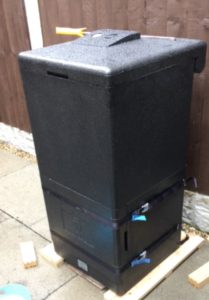From wildflower meadow to compost using the HOTBIN
I have been making compost since the mid-1980s and yes I absolutely love it. From composting flowers disposed of by a local crematorium that otherwise went to landfill to making compost from vegetables and weeds at the National Trust’s, Speke Hall, Liverpool.

HOTBIN in use
I used to compost my lawn mowings but what do you do when you have replaced it with a wildflower meadow?
My enthusiasm for making compost
Besides making many compost bins dotted around the northwest, I have made many organic raised no-dig beds as well, ideal for many of my students with special needs and elderly people. I wrote an article in 2006 ‘A bug’s life’ available to download from my article ‘The life in a compost heap-a bugs life’.
Local Council Compost Presentations
I gave scores of presentations for Local Councils. It started after I approached my Local Council with an idea. Before people received their free compost bin, they had to attend one of my presentations, have a card stamped by the Council confirming their attendance and show it at the Council premises where their compost bin could be collected. “There’s Mr Compost” I heard as I walked around town as many hundreds of people attended. I was in my element!
Then I designed an award-winning wormery which made composting a lot less physical and produces a more crumbly, friable and richer compost followed by a book I wrote about composting with worms.
Organic raised no-dig beds
Raised no-dig beds are ideal for piling compost onto the surface to replenish organic matter and sprinkle rock dust to replenish rock minerals in the autumn or spring.
Wherever possible I made my own compost bins from waste timbers, usually the New Zealand type of bins. One of the best commercially made bins I did buy was, if memory serves me right, called the Hot Rotter. It was basically four large pieces of thick polystyrene, covered with tough black plastic and tied together with cords through pre-installed eye holes. A similar lid was put on top. The HOTBIN is a more sophisticated model and absolutely works a treat. If I was to design a compost bin it would be similar to this with a few additional features. I’m glad to see that the MK 2 now has a leachate collection system.
To be honest I still enjoy the physicality of making compost, turning it and making more. However, I have to be realistic and this HOTBIN system requires less physicality something you have to bear in mind as you gain years! So yep, I do love compost making.
I do not receive any remuneration from HOTBIN for this article. I paid for the bin myself!

My compost post- I agree, I’ve been composting kitchen scraps (vegetal), lawn clippings and fall leaves for decades now. WIthout manure, it is usually a slow compost done mostly by worms. The bin has no cost, being 6 discarded wooden pallets set on end in a rectangle. And you are so right, that worm casting soil is simply grand, even for potted plants.
yours, jim
Sadly, I gave up making the wormeries, simply too large and cumbersome to make and package. I do think there is room for both methods though Jim. Cheers, George
Please can you explain what a leachate collection system is for a composter? The only info I could find on the internet was this (below) which isn’t relevant.
“Leachate is liquid generated from rainfall and the natural decomposition of waste that is filtered through the landfill to a leachate collection system. The leachate collection system’s job is to direct the leachate to collection sumps so it can be properly removed from the landfill.”
Thanks,
Fiona
Big question Fiona. A big difference between leachate from a landfill, ( chemicals, paints, oil, hazardous materials) than what is inside a compost bin containing purely organic matters in one form or another. Suggest you look at leachate from landfill and compare. Cheers George